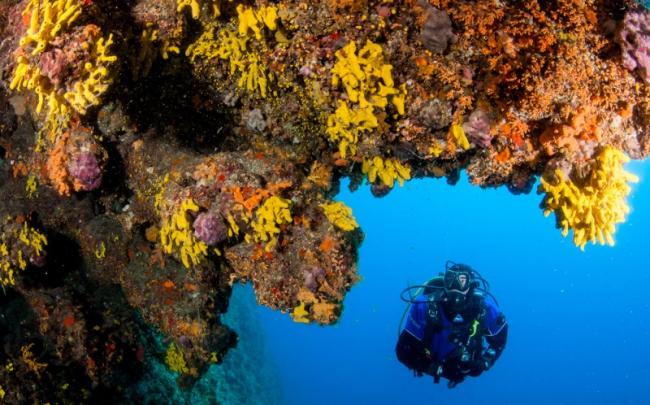
14. The colors of the Mediterranean Sea
We would like to introduce the colorful underwater world of the Mediterranean Sea.
Sometimes it's hard to decide where we should travel to dive. Some divers are interested in wrecks, there are keen technical divers but the majority prefers those dive sites where they can see beautiful, colorful flora and fauna. That's the reason why they choose tropical seas.
The coral gardens can be stunning indeed. But even in Europe we can find spectacular underwater environment if we dive a little bit differently. The basic rule: we should bring a dive light even daytime. Many people thinks the dives in the Mediterranean Sea are "boring" because it isn't that colorful- but they can be exciting as well if you know what to look for.
Certainly if you don't bring a dive torch and go deeper than 20-30 meters (which is typical there) you see only blue and grayish things which are anything but colorful. If you take one of the small but powerful Spark Lights dive lamp, you can see those colors even when you do a deep dive.
Those who dive in the Adriatic are often surprised to see the vivid color of the yellow gorgonians or the incredible purple of the red gorgonians- if you can't see anything else but the members of the Plexauridae family it worth bringing a dive light with you. The bright yellow or orange colors of the Axinella polypoides sponges may remind us to the colors of corals, but these are totally different animals. The only thing they have in common? You will need a dive light to see their real beauty! If you dive near a coral- or sponge covered area, we recommend to use the video-photo mode of Action Light 7F dive lamps to see it as a whole.

The different species of sponges usually dominate the colors of the specific spots in the Mediterranean. They live quite often in shady places or even in caverns, if you use your light in these places, you can see surprisingly spectacular colors thanks to the sponges.
Certainly the caverns and crevicles attract all divers who have an underwater light. In these places it's better to use the spot mode which don't frighten that much the animals. What can live in these holes and cracks? You can see spiny lobsters, moray eels or even catsharks. You have to be patient when you look into the diferent caves, and if you find something, you can examine them in the beam of your dive light, even when they try to hide.

This kind of dive is more about searching than swimming. The Mediterranean Sea has many well kept secrets so it's useful if you learn about its flora and fauna. If you know the different species, you will know where to find them. And you can recognize those smaller animals which you can't see at the first sight even if you use a dive light- and without a lamp it's simply impossible to see them.
We should mention some other colorful animals which you can see under water in the Mediterranean: the scorpionfish or the blennies for example. It's recommended to use your dive light when you see an empty bottle where small fish can live or cans which can be the home of an octopus. The octopuses are often live in holes, but be careful when you examine them: a curious octopus can steal your dive light! The seahorses live in shallow dive spots and they are experts in hiding. So you can use your dive light to show them to your dive buddy.

We mustn't forget about the colorful "celebrities" of the Mediterranean: the different species of nudibranchs. Some of them are really spectacular! When you illuminate them, you can see how exciting animals they are. Many divers' favourites the member of the Flabellinidae family which color can be purple, red or magenta. In the Chromodorididae family there are wonderful blue and yellow nudibranchs. The colorful Thuridilla hopei is one of the most spectacular sea slugs.
And we need to mention one of the iconic animals which we can see really often but without a dive light we simply can't understand why they are so famous: the red, purple or orange color of the sea stars became disappointing dull in the depth. The basic rule is the same: you will need a dive torch if you want to enjoy the real beauty of these animals.

So there are many spectacular, colorful dive spots and underwater species even in the Mediterranean. You need to know where to look for them, and certainly you will need a dive light for the dive or a strobe for underwater photography. If you are prepared to discover its wonders, the diving in the Mediterranean can be as exciting as in any other seas in the world.
2018.06.11.
 en
en EUR
EUR

